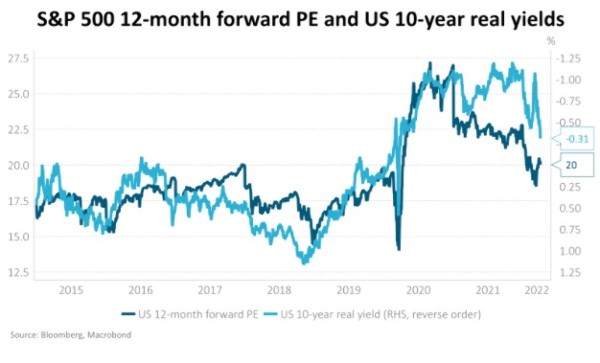Key points
- The MSCI All Country World (global shares) Index rose +2.4% in NZD hedged terms in March and, with the New Zealand dollar strengthening in the past month, the same Index fell -0.6% in NZD terms over the month.
- The New Zealand equity market (S&P/NZX 50 Gross with imputation) finished the month up 1.1%, whilst the Australian equity market (S&P ASX 200) rose 6.9% in AUD terms and 7.6% in NZD terms.
- Prompted by shifts towards faster rate hikes from offshore central banks and combined with large mortgage-based hedging flows domestically, market interest rates pushed relentlessly higher through the month, with the New Zealand 10-year Government bond yield ending at 3.2%, an increase of 0.5%.
- Potential easing of the conflict in Europe and a clearer path for US Federal Reserve (Fed) interest rate increases saw equity markets recover through March; while production disruption and Russian sanction constraints contributed to an increase in commodity prices with the price of oil increasing another 7% over the month.
Key developments
Global equity markets were mixed over the month with the US, Australia and New Zealand providing positive returns offset by European and Asian markets drifting lower. A further sharp lift in long term interest rates, clarity from the US Fed and oscillating geopolitical tensions contributed to volatility over the month.
Stock market sectors that are more sensitive to higher long-term government bond yields and interest rates more generally (especially fast growth technology stocks) were weak over the March quarter as investors anticipated the need for higher rates to offset inflation. During the March month though, prices of quality growth stocks recovered even as US 10-year bond yields rose +0.5% to 2.3% (New Zealand bond yields were up +0.5% to 3.2% and Australia up +0.7% to 2.8%). The key reason for the rally may have been that weakness in growth stocks early in the quarter captured a large degree of potential bond yield increases, and the likely economic slowdown due to policy change may make growth stocks’ underlying cycle-independent growth look relatively more attractive.
In Australia, energy and resource stocks continued to deliver strong returns reflecting tight supply demand dynamics. Bank stocks performed relatively well as investors allowed for earnings upgrade potential with higher interest rates lifting net margin income. In New Zealand, relaxation of international travel quarantine and isolation requirements provided a lift to the travel and tourism sector.
The Russian invasion of Ukraine represents a supply shock that has increased global energy and agricultural commodity prices. Russia is the world’s largest energy exporter and second largest exporter of oil behind Saudi Arabia. Brent crude prices have increased 40% year to date. Russia, Ukraine, and Belarus contribute 25% of the world’s wheat supply, along with large portions of other grains. Wheat and barley prices have increased 30-40% year to date. Supply fears have started to moderate more recently, however. The US announced that it will release 180m barrels of oil from its strategic reserves over the next 6 months and, with sanctions not extending to Russia’s energy exports, Putin has said gas will continue to be supplied according to existing long-term agreements.
While markets have already allowed for a sharp increase in rates, several global economists are picking that US 10-Year Government bond yields may exceed 2.75% in 12-months’ time. This is another step up from US 10-Year Government bond yields’ current 2.3%-2.5% range. Future commentary from the Fed has the potential to keep creating market volatility just as it did through March.
Central bank rate hikes to counter inflation and war in Ukraine have combined to make investors consider the risk of a stagflationary environment – stagnating economic activity and increasing inflation. This is not Harbour’s central investment scenario. However, with stock market valuations remaining full, the risk of stagflation does raise risk for stock market returns, as earnings may fall for more cyclically exposed stocks with economic activity slowing, and the return hurdle investors require increases with higher nominal, risk-free, government bond yields increasing.
What to watch
Real yields: valuations for the US stock market closely track 10-year real yields. This reflects those equities themselves are real assets. Theoretically equities should be more sensitive to the real discount rate (that excludes inflation) than the nominal discount rate (which does not). With inflation rates shooting up higher than nominal bonds, real rates have remained negative. Stocks with pricing power – the ability to pass on higher costs – should do relatively well in an such environment. Growth stocks, with earnings out in the future, are more sensitive to real rates, which increased (moved from being very negative to slightly negative) earlier in the year. Given higher inflation has halted the increase in real rates, growth stocks may look more compelling particularly as cyclical economic growth slows.

Market outlook and positioning
Equity markets may remain volatile as investors allow for central banks’ rate increases to offset inflation levels that have not been experienced for decades. War in Ukraine, in addition to causing significant human misery, increases the range of return outcomes for equity returns. Near-term equity returns may contribute positively to portfolio performance if real interest rates remain negative/low and earnings growth across the broader market remains positive. History suggests a more volatile period of returns with a higher risk of negative returns in some months reflecting the adjustment to higher interest rates.
Nominal interest rates globally, across all maturities, have risen sharply over the last three months as investors and central banks have acknowledged that multi-decade high inflation, triggered by the policy response to COVID-19 and extended by the war in Ukraine, is not going away quickly. Official cash rates are likely to continue to increase as central banks try and take some of the heat out of economies. Inflation is being driven higher by both excess demand and supply constraints. A policy of higher interest rates is likely to have a meaningful impact on potential household expenditure at a time when household incomes are already being hit by high inflation.
The key for markets is how much of the potential rise in interest rates is already built into market expectations, and the speed of tightening. Locally the Reserve Bank of New Zealand (RBNZ) has moved rates up earlier than expected and signalled a high terminal interest rate. Financial market participants have built in a further margin above the RBNZ’s interest rate track, meaning that fixed mortgage rates have already jumped higher. You could expect that New Zealand households may experience the downdraft of tighter monetary policy in coming months.
In contrast the Fed has been slower to take away stimulatory support put in place when COVID-19 hit. While it has started to lift rates, there is still uncertainty as to whether the Fed needs to accelerate the pace of rate hikes with 0.5% rate hikes in the next few official meetings.
Longer term bond yields have run up in advance of the rate hikes but have stopped increasing recently as economic growth has started to peak. A flatter yield curve – with little difference between near-term bond maturities and longer-term bond maturities – may signal a potential economic slowdown. Many commentators have made historical comparisons to the yield curve, increasing the prospects of a recession.
What does this mean for investments? In a lower-growth world, investors need to be careful about any investments, whether bonds or equities, dependent on cyclical activity. For stock markets, it may be a signal to move into growth stocks rather than cyclical stocks that are all about economic activity. Inversion in the U.S. Treasury yield curve, with near-term maturity rates higher than longer-term maturity rates, does not necessarily spell imminent trouble, in our opinion, as policy changes impact with long lags. Additionally, we would rather have policy focus on bringing down inflation.
Within equity growth portfolios, we are overweight versus benchmark in selected quality growth companies in the healthcare and information technology sectors, where the potential rate and sustainability of medium-term compound growth may not be fully reflected in share prices. The portfolios have selected investments in cyclical growth stocks in the materials and financial sectors that may benefit from structural change and have pricing power. Conversely, we are underweight to the New Zealand energy sector where disruption risk remains high, and the communications, real estate, infrastructure and utilities sectors where valuations are high relative to their potential growth and the potential for higher interest rates. More broadly, we are directing our stock research into understanding the longer-term implications of de-globalisation, the need for supply chain changes and the ability of businesses to pass on higher prices. Over the longer term, the conflict probably accelerates larger structural trends especially accelerating de-globalisation and investment in renewables in Europe.
Within fixed interest portfolios, we remain long duration. The position is concentrated in the 0-3 year and 10y+ sector. Short-term interest rates embody an expectation that the RBNZ will increase the OCR to 3.7%. We think this is too high given downside economic risks from slowing consumption and housing. At longer maturities, where yields are c.3.5%, New Zealand Government Bonds are highly attractive relative to other developed markets and inclusion into the FTSE/Russell World Global Bond Index later this year should also provide support.
Within the Active Growth Fund, we have sold our position in the US Financials sector as we believe that after offering outperformance during the initial interest rate shock earlier in the quarter, the relative upside for the sector is limited. We recycled this capital into Australasian equities as we continue to prefer the outlook for this region relative to global equities. We are also holding some cash in the fund to enable us to be opportunistic buyers as we experience market volatility.
Within the Income Fund, we held a modest underweight position in equities through the month. Position changes saw us remove our holding in European equities and replace that with US equities during the first half of March. After US equities had recovered, we reduced that position, taking overall equity exposure to 27%, where we remained through to month end. In fixed interest, we held a modest long duration position, as we had taken the view that the domestic market had sufficiently anticipated likely rate hikes from the RBNZ.
This does not constitute advice to any person www.harbourasset.co.nz/disclaimer




Comments
No comments yet.
Sign In to add your comment